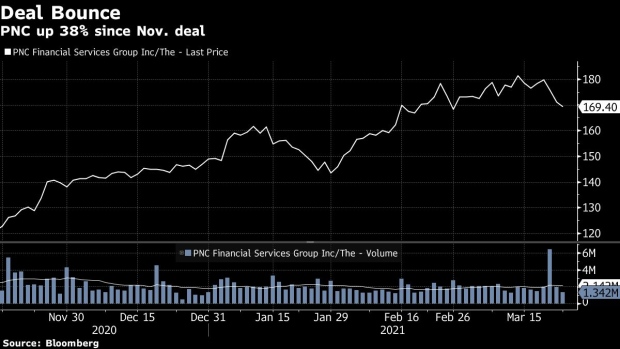Mar 24, 2021
Bank Mergers Send Stocks Higher as Investors Crave More Deals
, Bloomberg News

(Bloomberg) -- Last time several regional banks tried to do big deals, their investors weren’t always on board. Now, regional bank M&A is back and shareholders are cheering on the activity in a sector long ripe for consolidation.
Shares of four of the five of the U.S. regional banks that have announced transactions worth at least $1 billion in the past year are trading above their pre-deal prices, according to data compiled by Bloomberg. That’s a turnabout from several years ago, when markets frowned on deals and sent acquirers shares lower, the data show.
The warm reception reflects general optimism around bank stocks as the U.S. economy rebounds from the Covid-19 pandemic, with bank stocks and the economy tending to go hand in hand. The KBW Bank Index -- the industry benchmark -- is up about 19% this year. It also shows how investors are eager for transactions as the industry grapples with low-interest rates and competition from tech-savvy upstarts.
The 2019 merger of SunTrust Banks Inc. and BB&T Corp. helped usher in the current wave of consolidation, analysts at Moody’s Investors Service wrote in a March 18 note, after both shareholders and banking regulators welcomed that combination.
“The attractiveness of these transactions has grown in the past couple of years, partly because of favorable equity market response,” the analysts, led by Allen Tischler, wrote.
The proof: M&T Bank Corp. rose 3.5% the day it announced its $7.6 billion takeover of People’s United Financial Inc. in February. Huntington Bancshares Inc. is up about 18% since announcing its $6 billion deal in December for TCF Financial Inc., while PNC Financial Services Group Inc. has gained about 38% since striking its $11.6 billion pact for Banco Bilbao Vizcaya Argentaria SA’s U.S. operations in November.
That’s not what happened in early 2018, when Fifth Third Bancorp agreed to a $4.7 billion purchase of MB Financial Inc. or with Huntington’s $3.4 billion takeover of FirstMerit Corp. in 2016. Shares in both buyers tanked when they announced those transactions, on concerns over the financial impact of the deals.
“We have a pretty good backdrop for banks, generally,” said Jerry Wiant, head of banks and specialty finance at Bank of America Corp. “Everyone is thinking bigger -- bigger-sized deals, trying to get to scale faster, versus doing multiple, smaller transactions to get there.”
Buyers and sellers are also mindful of how their transactions will be received in the marketplace and are crafting deals accordingly, Wiant said.
“Sellers are being more reasonable in their price expectations,” he said. “If they are getting all stock -- stock of the buyer -- they want the stock to perform well.”
M&T, for example, agreed to pay just a 13% premium for People’s United, based on its closing price the day before the deal was announced. M&T expects the purchase to immediately boost tangible book value and says it will translate to an internal rate of return of more than 18%, according to an investor presentation.
As long as bank stocks keep climbing, there should be scope for more deals that investors find attractive, said Herman Chan, a senior analyst for Bloomberg Intelligence.
“The valuations of some of the larger banks are much more attractive relative to the smaller regional banks,” said Chan. “That just helps with digesting valuations of the smaller banks, and being able to do a transaction that doesn’t dilute the acquirer too much.”
Still, there’s only so much that the biggest banks can do. The four largest U.S. banks -- JPMorgan Chase & Co., Bank of America Corp., Citigroup Inc. and Wells Fargo & Co. -- can’t buy any more depositories for regulatory reasons.
©2021 Bloomberg L.P.